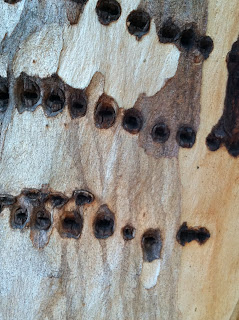 If you’ve hiked in the Puente Hills you’ve probably heard drumming
on trees or noticed horizontal holes drilled into trees with sap flowing from
them; all courtesy of a group of birds called sapsuckers. Sapsuckers belong to the bird Family Picidae
that includes woodpeckers. There are
about 200
If you’ve hiked in the Puente Hills you’ve probably heard drumming
on trees or noticed horizontal holes drilled into trees with sap flowing from
them; all courtesy of a group of birds called sapsuckers. Sapsuckers belong to the bird Family Picidae
that includes woodpeckers. There are
about 200 species of picids worldwide, of which two species of sapsuckers, Red-breasted sapsucker (Sphyrapicus ruber) and the red-naped sapsucker (Sphyrapicus nuchalis), have been confirmed on Habitat Authority managed land.
The Red-breasted Sapsucker is a medium sized woodpecker with a red head, nape, throat and breast,
cream colored belly, white rump and white moustache stripe. Preferring to drill sap wells in riparian species,
they inhabit forest edges and woodlands.
Breeding occurs from Alaska and British Columbia south to California and
wintering grounds are located throughout most of their breeding range. They are
cavity nesters and drill out new nest cavities typically annually. Their diet consists of sap, arthropods and
some fruits.
Red-naped
sapsuckers differ in that they have a red head and nape, cream breast and
belly. They breed in the Rocky Mountains
and winter in southern California typically along the edges of forests and
woodlands, especially groves of aspen and alder. They are also cavity nesters and their diet
consists of sap, arthropods and some fruits.
 Sapsuckers use their
strong bills to drill sap holes, collectively called sap wells, into living
trees and eat the sap along with some
insects that are attracted to, and get trapped by, the sap. The shape and size of the sap holes differs
by species and the holes drilled in these pictures were likely made by the
red-breasted sapsucker. These sap wells can
also be an attractant for species like hummingbirds who eat the sap that the
sapsucker keeps flowing. Large sap wells
can cause extensive damage to trees leading to tree mortality while other times
trees can heal themselves and continue growing.
Not all activities of sapsuckers are problematic. Sapsuckers usually excavate new nests every
year, leaving old nesting cavities for a variety of woodland/forest species to
inhabit.
Sapsuckers use their
strong bills to drill sap holes, collectively called sap wells, into living
trees and eat the sap along with some
insects that are attracted to, and get trapped by, the sap. The shape and size of the sap holes differs
by species and the holes drilled in these pictures were likely made by the
red-breasted sapsucker. These sap wells can
also be an attractant for species like hummingbirds who eat the sap that the
sapsucker keeps flowing. Large sap wells
can cause extensive damage to trees leading to tree mortality while other times
trees can heal themselves and continue growing.
Not all activities of sapsuckers are problematic. Sapsuckers usually excavate new nests every
year, leaving old nesting cavities for a variety of woodland/forest species to
inhabit.
So when you’re out
on the trail, keep your eyes and ears open for these wonderful birds!